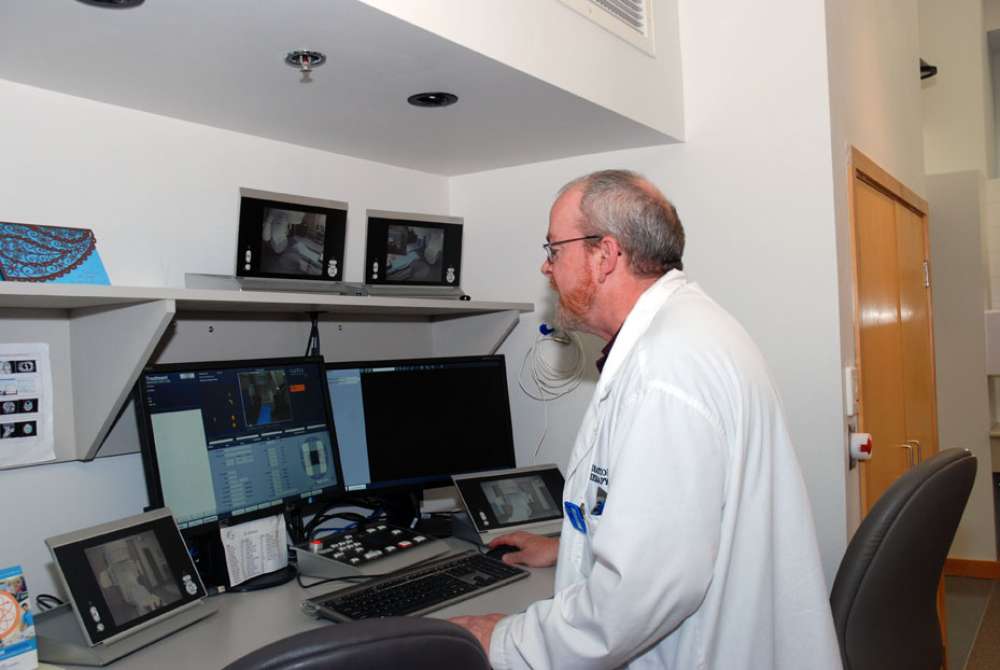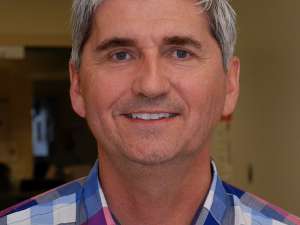
Given that Bruce Fleming has worked as a radiation therapist for 30 years, he’s certainly heard his share of questions and misconceptions about radiation therapy.
He shares with patients that radiation is both a viable and secure treatment option for many cancer patients as it is a localized treatment to target unhealthy cells while minimizing damage to healthy cells.
“We develop good patient-therapist bonds that help us treat the patient as a whole person, not just as a cancer patient. It helps us to take the ‘I’ out and replace it with ‘we.’ Working in this field has broadened my outlook on life and made me appreciate the smaller things because life can hand you a big challenge at any time.”
What does radiation therapy entail?
Radiation therapy uses differently-angled radiation beams to treat cancerous tumours. A patient comes to have a specialized CT scan first for us to map out the area that we need to treat.
After a radiation oncologist meets with a radiation therapist (planner) to formulate a treatment plan, the patient comes back for their first treatment.
The radiation therapist will meet with the patient, provide education about what to expect then sets the patient up according to the treatment plan and delivers the radiation therapy treatment from one of our 4 linear accelerators in the department.
What do you think is important for people to know about radiation?
That radiation is a very safe and viable treatment option.
The treatment rooms and equipment we use are built to very precise specifications. There are many safety mechanisms built into the treatment machines to prevent them from being turned on if all of the patient data is not correct.
The machines are monitored and have regular maintenance times throughout the year. Radiation treatment is a very precise and accurate treatment that has a lot of quality assurance work done before a patient steps into the clinic for their first appointment.
Also, one common misconception is that people will be radioactive after they have external radiation beam treatment, which is entirely false.
What are the benefits to this type of treatment?
There are several benefits to this type of treatment. First, the treatment is often given on an outpatient basis, allowing the patient to keep their routine to as close to normal as possible.
Second, we can focus the radiation in a way that will kill cancer cells and minimize damage to normal healthy cells in the treatment area.
Third, the patient has access to many different healthcare professionals to help them along their journey without having hospital admission.
What can someone expect during radiation therapy?
Patients can expect to be treated by the same team of radiation therapists daily, in most cases. A patient may be anxious about what is going to happen during their treatments, but the expertly-trained therapists will help put the patient at ease by educating them on what they will be going through technically and physically, and what side effects they might experience.
We stress that we will constantly monitor them and that they just need to communicate to us any questions or concerns. We try to encourage asking questions and will refer them to other allied health professionals when needed.
How has your field changed throughout your career?
In my 30 years as a radiation therapist, I have seen many significant changes.
Computer technology has evolved so quickly and rapidly that has brought many advances and greater efficiencies into our field.
Things are constantly changing, and treatment techniques are more and more complex to limit side effects while still delivering the most beneficial arrangement of radiation beams.


 Dr. Peter Potts: care and support for families at a pivotal time
Dr. Peter Potts: care and support for families at a pivotal time Goran Petrovic: putting patient safety first with medication management and pharmacy automation
Goran Petrovic: putting patient safety first with medication management and pharmacy automation  Danielle Vucenovic: Bringing HELP to those at GRH
Danielle Vucenovic: Bringing HELP to those at GRH